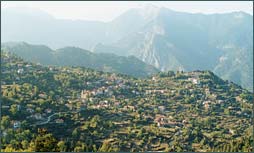
Ano Chora is linked to the great Byzantine family Kanaveoi from which an emperor came. After the Franks conquest in 1204 and later the Ottomans the invasion in 1453 Constantinople many seigniorial families of the city escaped to safer places. The establishment of Kanaveoi in Kravara is unclear as there is no solid evidence. We meet written proof of Kanaveoi in Kravara in 1739. One thing is certain that they were leaders not only in Ano Chora but in all the villages of Kravara. Kanaveoi also founded the great Academy of Ano Chora. But Kanaveoi were banished between 1800 and 1801 by Ali Pasa and were forced to seek refuge in Egio thus the Academy closed. We should mention that Father Kosmas of Aetolia had attended the academy during 1734 and taught in the school until 1738. The last of Kanaveoi family was Ioannis Nikolaou Kanavos (1866-1953) who was elected as Member of the Parliament but also as Senator and Minister for many times.
Undoubtedly the natural environment of the village is its greatest enticement. The forests are a natural mosaic made of many different types of trees such as: chestnut, fir, cedar oak and other. Amongst the fir, chestnut, cedar trees and fern there are many springs.
During these past years Ano Chora is taking full advantage of its natural beauty and social infrastructure like the Health Centre in order to create attractive tourist infrastructure that will make the village a tourist destination. The old stonemason houses but also the new ones have blended in the natural environment; the traditional cafés and the cobblestone streets; the traditionally built hotels and guesthouses under the big plane trees, make up an idyllic atmosphere and grab the attention of the observer. The church of Agia Paraskevi (1918) is also magnificent with its two imposing cruciform bell towers built with carved black stones. The icons of Agia Paraskevi and Panagia SKopiotissa also stand out.
Moreover, there is much to see from the Lakoula Hill to the hill of Aye Giorgi. Even the small bus (Karnavalos) served as public transportation until 1983. Now it is on display by Agia Paraskevi church. During mid-October the chestnut and tsipouro festival is organised where tsipouro is distilled; roasted chestnuts, traditional pies, stew and deserts served (baklava, ravani, kourabie, cherry, chestnut, walnut, quince).
SEE ALSO
